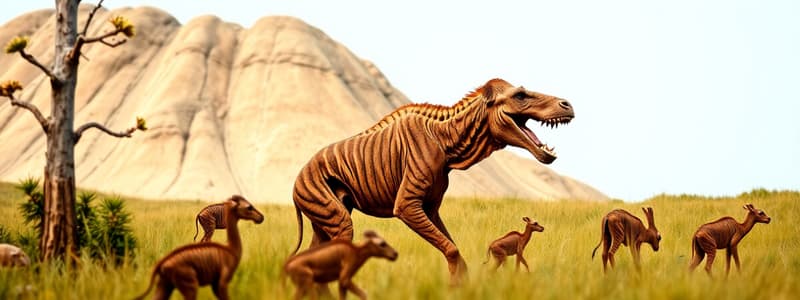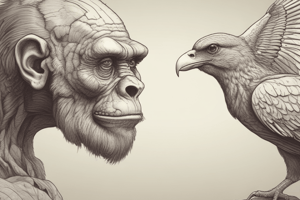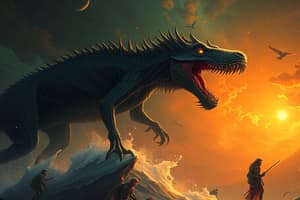Podcast
Questions and Answers
What is the primary diet of Geospiza fortis on Daphne Major?
What is the primary diet of Geospiza fortis on Daphne Major?
- Fruits
- Insects
- Nectar
- Seeds (correct)
The heritability of a trait varies from 0 to 1.
The heritability of a trait varies from 0 to 1.
True (A)
What is the name of the species of finch studied in the example of natural selection?
What is the name of the species of finch studied in the example of natural selection?
Geospiza fortis
The population of Geospiza fortis on Daphne Major consists of approximately ______ individuals.
The population of Geospiza fortis on Daphne Major consists of approximately ______ individuals.
Match the following concepts with their definitions:
Match the following concepts with their definitions:
What type of selection is exemplified by the findings in Darwin's finches?
What type of selection is exemplified by the findings in Darwin's finches?
What was one of Darwin's primary areas of interest during his voyage on the Beagle?
What was one of Darwin's primary areas of interest during his voyage on the Beagle?
All individuals of Geospiza fortis tend to move away from Daphne Major after being measured.
All individuals of Geospiza fortis tend to move away from Daphne Major after being measured.
Darwin and Wallace independently proposed the theory of natural selection.
Darwin and Wallace independently proposed the theory of natural selection.
What is the main focus of the studies conducted by the Grants on Geospiza fortis?
What is the main focus of the studies conducted by the Grants on Geospiza fortis?
What model of evolutionary change did Darwin establish?
What model of evolutionary change did Darwin establish?
Natural selection is one agent of evolution, while __________ and genetic drift are also agents of evolution.
Natural selection is one agent of evolution, while __________ and genetic drift are also agents of evolution.
Match the following concepts with their definitions:
Match the following concepts with their definitions:
Which factor did Darwin believe was crucial for evolution to take place?
Which factor did Darwin believe was crucial for evolution to take place?
Darwin published his findings on natural selection immediately after his voyage on the Beagle.
Darwin published his findings on natural selection immediately after his voyage on the Beagle.
What significant change in population characteristics does evolution represent?
What significant change in population characteristics does evolution represent?
Darwin argued that the changes in heritable characteristics of a population result in __________ as a necessary consequence.
Darwin argued that the changes in heritable characteristics of a population result in __________ as a necessary consequence.
What was the primary reaction of the scientific community to Darwin's theory shortly after publication?
What was the primary reaction of the scientific community to Darwin's theory shortly after publication?
What was the effect of the major drought in 1977 on the finch population in G. fortis?
What was the effect of the major drought in 1977 on the finch population in G. fortis?
Differential survival and reproduction was influenced by beak size in G. fortis during droughts.
Differential survival and reproduction was influenced by beak size in G. fortis during droughts.
Name one condition that is necessary for evolution by natural selection.
Name one condition that is necessary for evolution by natural selection.
The average beak size of offspring of survivors after the drought was _____ than the average of the population before the drought.
The average beak size of offspring of survivors after the drought was _____ than the average of the population before the drought.
Match the following concepts with their definitions:
Match the following concepts with their definitions:
Which of the following factors contributed to the natural selection observed in G. fortis?
Which of the following factors contributed to the natural selection observed in G. fortis?
Natural selection is the only mechanism of evolutionary change.
Natural selection is the only mechanism of evolutionary change.
What type of seeds became more available during droughts, impacting the finch population?
What type of seeds became more available during droughts, impacting the finch population?
What is indicated by a heritability estimate of 0 for a trait in G. fortis?
What is indicated by a heritability estimate of 0 for a trait in G. fortis?
Which of the following best describes the struggle for existence related to G. fortis?
Which of the following best describes the struggle for existence related to G. fortis?
Which of the following statements is true about the population of G. fortis on Daphne Major?
Which of the following statements is true about the population of G. fortis on Daphne Major?
What type of selection is demonstrated by changes in beak size in G. fortis due to environmental pressures?
What type of selection is demonstrated by changes in beak size in G. fortis due to environmental pressures?
Which aspect of G. fortis was found to vary among individuals on Daphne Major?
Which aspect of G. fortis was found to vary among individuals on Daphne Major?
What role does differential reproduction play in the evolution of G. fortis?
What role does differential reproduction play in the evolution of G. fortis?
What factor is most important for understanding heritable variation in G. fortis?
What factor is most important for understanding heritable variation in G. fortis?
Which statement best reflects the concept of natural selection as observed in G. fortis?
Which statement best reflects the concept of natural selection as observed in G. fortis?
What demographic effect occurred in the G. fortis finches as a result of the 1977 drought?
What demographic effect occurred in the G. fortis finches as a result of the 1977 drought?
Which condition did not contribute to the natural selection observed in G. fortis?
Which condition did not contribute to the natural selection observed in G. fortis?
How did the drought affect the survival rates of finches based on their beak size?
How did the drought affect the survival rates of finches based on their beak size?
What can be inferred about the offspring of the finches that survived the drought?
What can be inferred about the offspring of the finches that survived the drought?
Which statement reflects the consequence of natural selection in G. fortis?
Which statement reflects the consequence of natural selection in G. fortis?
Which of the following conditions was essential for natural selection to occur in G. fortis?
Which of the following conditions was essential for natural selection to occur in G. fortis?
What was a direct result of the major drought in 1977 on the finch population?
What was a direct result of the major drought in 1977 on the finch population?
How is evolution by natural selection best defined in the context of G. fortis?
How is evolution by natural selection best defined in the context of G. fortis?
What is NOT one of the five key pieces of natural selection as described by Darwin?
What is NOT one of the five key pieces of natural selection as described by Darwin?
What primarily influenced Darwin's understanding of struggle in natural selection?
What primarily influenced Darwin's understanding of struggle in natural selection?
Which statement best describes Darwin's publication approach regarding his theory of natural selection?
Which statement best describes Darwin's publication approach regarding his theory of natural selection?
How does natural selection contribute to evolution according to Darwin?
How does natural selection contribute to evolution according to Darwin?
What distinguishes differential reproduction in natural selection?
What distinguishes differential reproduction in natural selection?
What was Darwin's stance on heritable variation before it was fully understood?
What was Darwin's stance on heritable variation before it was fully understood?
Which best describes the relationship between Darwin and Wallace?
Which best describes the relationship between Darwin and Wallace?
What type of evidence did Darwin rely on to support his arguments for evolution?
What type of evidence did Darwin rely on to support his arguments for evolution?
Which of the following is NOT considered an agent of evolution?
Which of the following is NOT considered an agent of evolution?
What is one primary factor that drives evolution as defined by Darwin?
What is one primary factor that drives evolution as defined by Darwin?
Flashcards are hidden until you start studying
Study Notes
Darwin and Natural Selection
- Darwin was a lifelong naturalist, trained in medicine and for the clergy
- He embarked on a five-year voyage on the Beagle at age 22, initially not an evolutionist but interested in variation and biogeography
- He developed the basic argument for natural selection: variation (observable but underappreciated), heritable variation (known to occur but not how), struggle (influenced by Malthus), differential reproduction based on heritable variation, and changes in the population's characteristics (evolution).
- Darwin was slow to publish his findings due to the intellectual climate, likening it to confessing murder.
- He amassed evidence and conducted experiments over 15 years.
Alfred Russel Wallace
- Wallace independently developed a similar theory of evolution, co-publishing his findings with Darwin.
Darwin's Accomplishments
- Established evolution, providing overwhelming evidence and a clear argument for an old idea.
- Proposed a plausible mechanism for evolutionary design, widely accepted after 1859.
Natural Selection
- Evolution: changes in genetic characteristics of a population over time.
- Natural Selection: one agent of evolution that leads to a fit between traits and surroundings.
- Other agents of evolution include mutation, migration, and genetic drift.
Five Key Components of Natural Selection
- Variation: There must be variation in traits within a population.
- Heritability: The variation must be heritable, passed down from parents to offspring.
- Struggle: Organisms compete for resources, facing challenges for survival.
- Differential Reproduction: Individuals with advantageous traits survive and reproduce more successfully, passing on those traits to their offspring.
- Evolution: As a consequence of the first four factors, the population evolves, changing its genetic makeup over generations.
Darwin's Finches
- 14 species of finches on the Galapagos Islands, similar in appearance but differing in beak dimensions.
- Their beak size has evolved as a response to their environment and the available food sources.
Geospiza fortis (Medium Ground Finch)
- Studied by the Grants, et al. on Daphne Major island in the Galapagos.
- This population is well-documented and serves as an example of natural selection.
- The finches are primarily seed eaters and live on a small island with a relatively stable population.
- The Grants have been able to track and measure almost all individuals on the island.
Variation in Geospiza fortis
- Variation exists in beak dimensions among the finches.
Heritability in Geospiza fortis
- The variation in beak dimensions is heritable.
- Heritability is measured as the proportion of variation due to genes, ranging from 0 (variation entirely environmental) to 1 (variation entirely genetic).
- Researchers can estimate heritability by comparing offspring traits to their parents.
Struggle for Existence in Geospiza fortis
- There is always a struggle for existence, especially during periods of environmental stress.
- Droughts can lead to starvation on Daphne Major, causing a significant die-off of finches (up to 85%).
Differential Survival/Reproduction in Geospiza fortis
- During droughts, smaller seeds are less abundant, favoring finches with larger beaks better suited to eating larger seeds.
- Finches with larger beaks survived the drought in greater proportions, illustrating differential survival/reproduction.
Evolution in Geospiza fortis
- The Grants demonstrated the five components of natural selection in Geospiza fortis: variation, heritability, struggle, differential survival/reproduction, and resulting evolutionary change.
- The average beak size of surviving offspring was larger than the average of the population before the drought.
Summary: Natural Selection
- Natural selection is a powerful agent of evolutionary change.
- Evolution is an inevitable consequence of variation, heritability, struggle, and differential reproduction.
- These components can be studied in the field (e.g., finches) and in lab settings.
Charles Darwin
- A lifelong naturalist who studied medicine and the clergy
- In 1831, at 22, boarded the Beagle for a five-year voyage
- Darwin started out not believing in evolution, but took interest in variation and biogeography during his journey
Darwin's Theory of Natural Selection
- Darwin recognized that populations display variation in their traits, some of which are inherited.
- Darwin believed there was a struggle for existence, influenced by Malthus who described how populations grow exponentially while resources remain limited
- He observed that individuals with specific inheritable traits are better suited for survival and reproduction
- According to Darwin, the changes in inheritable traits (evolution) are a consequence of differential reproduction, and were passed down through generations
Darwin's Delay and Impact
- Darwin delayed publishing his theory, as it went against established religious views
- He belonged to a group of intellectuals, and worried the impact of his theory (comparing it to confessing murder)
- Darwin gathered extensive evidence and experimented for 15 years after his voyage
- Darwin's work led to the widespread acceptance of the concept of evolution, though the mechanism for evolutionary change was not universally accepted
Alfred Russel Wallace - Joint Publication
- Wallace independently developed the same theory as Darwin
- Darwin and Wallace co-published their theories
- Wallace's work is also celebrated and fascinating, as described in Quammen's "Song of the Dodo"
Evolution & Natural Selection
- Evolution is defined as changes in the genetic characteristics of a population over time
- Natural selection is one agent of evolution and leads to organisms' characteristics being better suited to the environment
- Other drivers of evolution include mutation, migration, and genetic drift
Five Easy Pieces of Natural Selection
- Variation within a population is necessary
- Variation must be inheritable
- There must be a struggle for existence
- Differential reproduction occurs based on inherited variation
- Changes in the heritable characteristics of the population - evolution is the natural outcome
Evolution of Darwin's Finches
- Finches on the Galapagos islands are intensely studied, specifically the medium ground finch (Geospiza fortis)
- The Grants and their team document real-world natural selection through these finches, described in Jonathan Weiner's "The Beak of the Finch"
Darwin's Finches - Variation and Heritability
- Darwin's finches show variation in their bill dimensions
- Studies show that at least some of this variation is heritable, meaning it can be passed down to offspring
Darwin's Finches - Struggle for Existence
- Finches experience a struggle for existence, particularly during droughts as food is scarce
- Drought in 1977 on Daphne Major, an island in the Galapagos, resulted in a significant drop in food availability
- This drought led to the death of almost 85% of the finch population
Darwin's Finches - Differential Reproduction
- Finches with larger beaks survive better during droughts because they are successful at eating larger, harder seeds
- This leads to a higher survival rate and increased reproduction for larger-beaked finches
Darwin's Finches - Evolution
- The offspring of finches who survived had larger beaks than the average of previous generations
- This is evolution in action - the population's genetic characteristics have changed over time driven by natural selection
Natural Selection as an Agent for Change
- Natural selection is a powerful driver of evolution
- The four conditions of natural selection are variation, heritability, struggle, and differential reproduction, and can be studied in the field (e.g. finches) and in laboratory settings
Studying That Suits You
Use AI to generate personalized quizzes and flashcards to suit your learning preferences.




